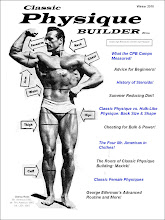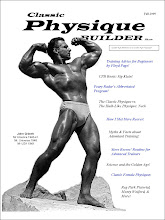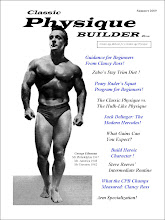 (Photo above: Steve Reeves, Mr. America 1947, Mr World 1948, Mr Universe 1950)
(Photo above: Steve Reeves, Mr. America 1947, Mr World 1948, Mr Universe 1950)Once you've decided to embark on your destination of building a classic physique, the next step is to have a good "road map." It is critical, at the outset, that (1) you have a clear understanding of what a classic physique is, and (2) clear goals in terms of size and symmetry.
In previous posts (click on the Classic Physique Ideal and Classic Physique vs Hulk-like Physique labels on the side bar), we have reviewed the characteristics of a classic physique. The basic symmetry and proportion goals for a classic physique are:
1) neck, arms, and calves measure the same (or very close)
2) broad shoulders (without overdeveloped traps),
3) narrow waist and hips (with broad shoulders to create that "V-taper")
4) straight legs (without overdeveloped adductors)
In terms of size goals, a good place to start is by becoming familiar with the measurements of the Mr. America champions of the pre-steroid, Golden Age of Classic Physique Building (1940-1959/60). You can find an article at the musclememory website that lists their measurements by clicking here: http://www.musclememory.com/articles/MrAsizes.html. Look at their height and compare it to your own. Look at the size of their neck or arm. That will give you a good idea of what you can shoot for in terms of size. Now, perhaps you might have larger bone structure and can be a bit bigger, or perhaps you have smaller bone structure and will be a bit smaller. But it gives you a good, ball-park starting size goal. Once you see their arm or neck measurement (for your height), then you have a general size goal.
How can you apply these symmetry and size goals? Let's give an example. First, measure your neck, arm, and calves. Which of these three is the largest? Let's suppose that your neck is the largest measurement. Perhaps arms are next, with calves being the smallest. In that case, the first step would be to bring your arms and calves up to your neck measurement. Because your arms are larger than your calves, they will probably reach the goal first. After that, then you would focus more on your calves (backing off a bit on arms) - until all 3 (neck, arms, and calves) finally have the same measurement. Then, with your body in symmetry, you would adjust your training to bring up the mass for all three until your reached your overall size goal. The point is that your goal, at the outset, should be proportion & symmetry, not just size.
When Steve Reeves began building his classic physique as a beginner, his calves were already 16 inches, while his arms were only 13 inches. So he didn't even train his calves at all until his arms and neck matched his calves. Then, when they all measured 16 inches, he then brought up their mass together until they all measured 18 1/4 inches. So, as a beginner, his goal was proportion and symmetry, not just size.
By the way, Steve did not directly train his abs! Why? He didn't want to make his waist larger - which would reduce his shoulder-waist "V-taper". We all have "six-packs" already (that is the way the rectus abdominis is naturally constructed) and it is a proper definition diet that will bring them out. Exercising the abs and obliques will only make the waist larger - which is not desirable for a classic physique. So think twice before you do all those side bends! If your waist is not naturally narrow, it is even more important not to increase the size of the muscles of the waist! Ab training is really "in" these days, but just be careful. Keep a close eye on your waist measurement, and if ab training is making your waist larger, then you will probably want to "back off" if you want to build a classic physique.
So keep your symmetry and size goals clearly in mind at the outset. Adjust your training to achieve those goals. With a clear "road map" of these goals, you will reach your destination more easily and won't fall into the trap of just building the "T-shirt" muscles (biceps and chest) while walking around on "tooth-pick" legs - a common site in today's gym's and fitness centers!
There is much more that we could say here, but this is perhaps enough to get you going in the right direction! - CPB







No comments:
Post a Comment